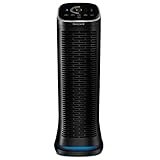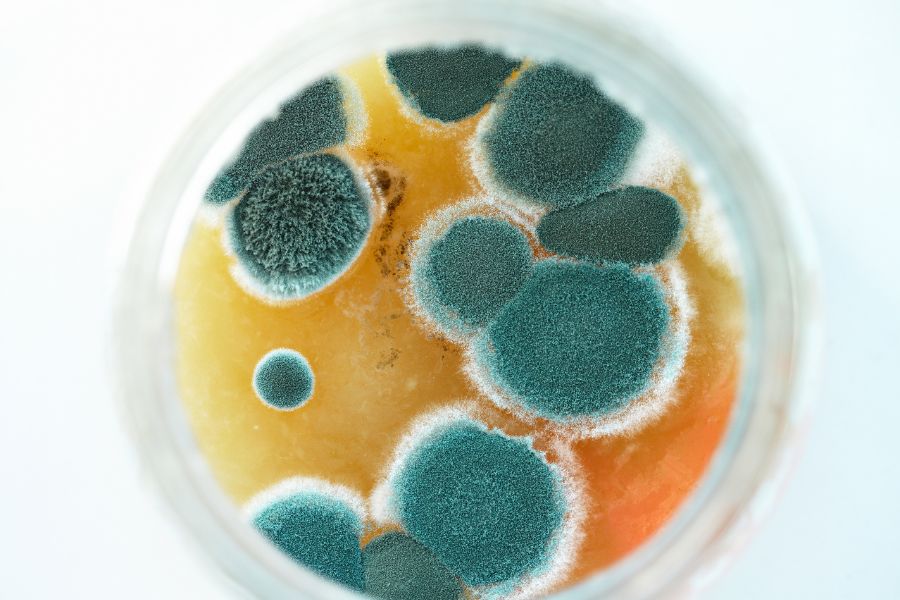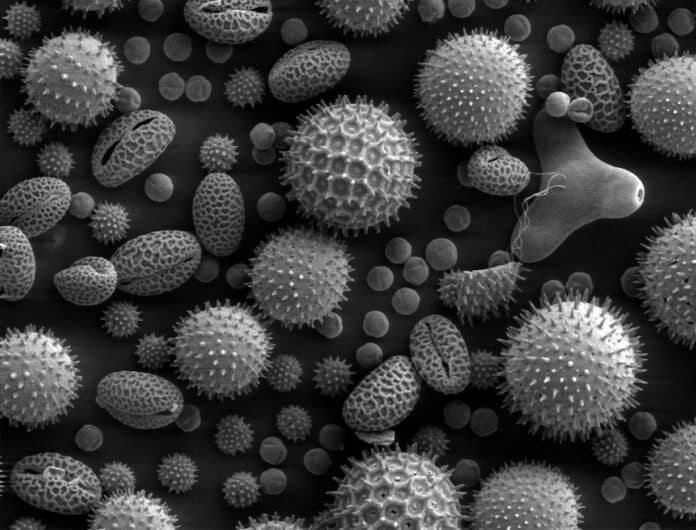If you have a runny nose, watery eyes, itchy skin, or other symptoms that make you feel discomfort at home, there is a high possibility that allergens live in your home. Identifying these allergens is crucial for maintaining a healthy indoor environment and minimizing allergic reactions. Among the myriad of potential culprits, three stand out as the most common household allergens: dust mites, mold, and pollen. In this article, we will delve into these pervasive irritants and explore how to mitigate their impact on your well-being.
Table of Contents
What Are The 3 Most Common Household Allergens?
Dust mites

Dust mites (also called bed mites) is cosmopolitan pyroglyphid that lives in human habitation. These microscopic arachnids are one of the main allergy offenders for people with allergic asthma.
In the unseen world that exists within our homes, there’s a tiny yet troublesome inhabitant that goes by the name of dust mites. These microscopic arachnids, also known as bed mites, are cosmopolitan pyroglyphids that thrive in human habitation, causing a big nuisance, especially for those with allergic asthma.
Dust mites love and reproduce quickly in warm (temperatures at or above 70 degrees Fahrenheit) and humid (70 to 80 percent) places.
Dust mites die when the humidity goes below 50 percent. They are not typically found in dry climates. Dust mites are usually located in pillows, carpets, mattresses, and upholstered furniture since they live on dead skin and dander.
Meet the Culprits
Dust mites have a particular penchant for warm, humid environments, with temperatures at or above 70 degrees Fahrenheit and humidity levels between 70 to 80 percent being their ideal breeding grounds. Unfortunately, they meet their demise when humidity levels drop below 50 percent, meaning they are not commonly found in dry climates. These minuscule creatures primarily reside in pillows, mattresses, carpets, and upholstered furniture, feasting on dead skin cells and dander.
The Health Hazard
While they may be tiny, dust mites pack a punch when it comes to health hazards. The particles they shed can irritate nasal passages and respiratory tracts, triggering allergic reactions and exacerbating conditions like asthma.
Banishing the Uninvited Guests
The battle against dust mites may seem like an endless one, but there are steps you can take to significantly reduce their numbers and minimize their impact on your health and home environment.
They are harmful when breathed since they irritate nasal passages and respiratory tracts.
How do you get rid of them?
The sad news is that dust mites cannot be eliminated no matter how clean a home is. But, the number of dust mites can be decreased significantly if you do your homework.
- Minimize household humidity. To do that, use a dehumidifier to keep relative humidity between 30 to 50 percent.
- Remove wall-to-wall carpets, especially in the bedroom: better use bare floors – linoleum, tile, or wood.
- Use mattresses and pillows in dust-proof or allergen-impermeable covers. Also, wash all bedding and blankets often in hot water.
- Keep pets out of the bedroom and preferably out of the house.
- Use a wet mop or rag to remove dust. Never use a dry cloth.
- Clean your house regularly using a vacuum with a HEPA filter.
- I recommend using an air purifier in the bedroom and other rooms if necessary. First, what comes to my mind is any model from AirDoctor or Alen BreatheSmart.
If you want to learn more about dust mites and have questions like, can humans get dust mites or can a dusty house cause eczema, read my Dust Mites article.
Dust mites may be invisible to the naked eye, but their presence can have a significant impact on our health and quality of life, particularly for those with allergies and respiratory conditions. By implementing proactive measures to control humidity, maintain cleanliness, and minimize allergen exposure, you can effectively manage dust mites and create a healthier indoor environment for you and your family.
If you’re curious to learn more about dust mites and how they can affect human health, including whether humans can “get” dust mites or if a dusty house can cause conditions like eczema, delve deeper into the topic to arm yourself with knowledge and strategies for a dust mite-free home.
| Available | On | Amazon | ||
|---|---|---|---|---|
| Add To Cart |  | Blueair | PrimeEligible | |
| Add To Cart |  | Kazravan Enterprises LLC | PrimeEligible | |
| Add To Cart |  | Honeywell | PrimeEligible |
Mold and Mold Spores

Molds are multiple fungi that grow in filaments and reproduce by creating spores. The mold grows in damp, warm, and humid conditions. Mold can be found in basically any environment or season.
The most common places where you can find molds are bathrooms and basements, sometimes hidden behind wallpaper and within the drywall. Keep an eye out for water drips and broken appliances, which create a breeding spot for mold. Musty smells are another key indicator that you could have a mold problem.
Molds produce irritating substances that can act as allergy-causing elements (allergens) in sensitive persons. Some molds create toxic substances known as mycotoxins, but mold itself is not dangerous or toxic.
The mold may not generate any health impacts or lead to symptoms in people who are sensitive to molds.
Molds, those pesky fungi thriving in damp, warm, and humid conditions, are more common than you might think. They reproduce by creating spores, spreading easily in various environments and seasons. From bathrooms to basements, mold can lurk behind wallpaper, within drywall, and other hidden spaces, making it essential to stay vigilant for signs of its presence.
Spotting mold isn’t always straightforward. Musty odors often accompany mold growth, serving as a telltale sign of a potential problem. However, even without visible signs or odors, mold might still be present, posing health risks, particularly to sensitive individuals.
Molds produce allergens and, in some cases, toxic substances known as mycotoxins. While mold itself isn’t inherently toxic or dangerous, its presence can trigger allergic reactions and exacerbate respiratory issues in susceptible individuals. Therefore, understanding how to identify, prevent, and manage mold growth is crucial for maintaining a healthy indoor environment.
How to limit mold in the household?
The best way to control mold growth is to control moisture. It is impossible to defeat all mold spores. The mold spores will not increase without moisture, so controlling moisture is the solution to limiting mold growth.
To limit mold growth in your household, moisture control is paramount. Mold spores are ubiquitous but won’t proliferate without moisture. Here are some practical tips to help you combat mold:
- Promptly Address Water Issues: Repair leaks in plumbing or other water-related problems as soon as they’re detected. Ensure that all affected areas are thoroughly dried to prevent mold growth.
- Thoroughly Clean Affected Areas: If mold has already taken hold, clean affected surfaces with a mixture of detergent and water. After cleaning, ensure that the area is completely dry to discourage further mold growth.
- Choose Materials Wisely: Avoid using absorbent or porous materials, such as carpets, in areas prone to moisture, like basements and bathrooms. Opt for moisture-resistant alternatives where possible.
- Improve Ventilation: Proper ventilation is key to reducing humidity levels indoors. Use exhaust fans in bathrooms and kitchens, and consider installing vents in high-moisture areas to promote airflow and discourage mold growth.
- Ventilate Appliances: Ensure that appliances like clothes dryers and stoves are properly vented to the outdoors. This prevents moisture buildup indoors, reducing the likelihood of mold growth.
- Utilize Dehumidifiers: During humid seasons, maintain indoor humidity levels between 30 to 50 percent using dehumidifiers. Lower humidity inhibits mold growth and creates a less hospitable environment for spores.
- Invest in Air Purifiers: Consider using air purifiers equipped with HEPA filters to trap mold spores and other airborne pollutants, improving indoor air quality and reducing the risk of mold-related health issues.
By implementing these preventive measures and staying proactive in managing moisture levels in your home, you can effectively limit mold growth and create a healthier living environment for you and your family. Remember, early detection and swift action are key to mitigating the potential risks associated with mold proliferation.
Pollen

Pollen is an airborne allergen (a fine yellow powder) picked up and moved by the wind, birds, insects, or other animals.
Various trees, grasses, and weeds produce pollen, which for many people, is a year-round problem and even more aggravating when it makes its way into their homes.
Pollen is one of the several common allergens in the United States. Over 67 million people suffer from allergies; of those 67 million, 81% say they are allergic to pollen.
To keep pollen outside, switch clothes and shoes immediately after returning indoors. Wash pets when they enter, too, as their fur and paws quickly track pollen into the house.
Also, during the pollen season, keep your doors and windows closed. Regularly clean carpets and surfaces; I also recommend using an air purifier to remove pollen from your indoor environment.
Here are some effective strategies to keep pollen outside and create a more pollen-free environment indoors:
- Change Clothes and Shoes: Upon returning indoors, make it a habit to change out of the clothes and shoes you wore outside. Pollen particles can easily cling to fabric and footwear, so swapping them out can prevent them from spreading throughout your home.
- Pet Maintenance: Pets can unwittingly track pollen indoors on their fur and paws. To minimize pollen transfer, consider wiping down your pet’s fur or giving them a quick rinse after they’ve been outside, particularly during high pollen seasons.
- Close Doors and Windows: While it’s tempting to let in the fresh air, keeping doors and windows closed during peak pollen times can significantly reduce the amount of pollen that enters your home. Use air conditioning instead to circulate air and keep indoor environments comfortable.
- Regular Cleaning: Pollen settles on surfaces, carpets, and upholstery, so regular cleaning is essential for reducing its presence indoors. Vacuum carpets and rugs frequently using a vacuum cleaner equipped with a HEPA filter to trap pollen particles effectively. Wiping down surfaces with a damp cloth can also help capture pollen and prevent it from becoming airborne.
- Air Purifiers: Consider investing in an air purifier with a HEPA filter to help remove pollen from indoor air. Place the air purifier in commonly used rooms, such as the bedroom and living room, to ensure maximum effectiveness.
By implementing these practical measures, you can create a more pollen-free environment within your home, providing much-needed relief for allergy sufferers. While it may not be possible to entirely eliminate pollen exposure, taking proactive steps to minimize it can significantly reduce symptoms and improve overall well-being during allergy season and beyond.
Do You Have Any Of These Allergens In Your Home?
Do some testing. Do-it-yourself (DIY) testing kits let you take control of your environment on your schedule and at a reasonable cost.
Several testing kits are available on the market, each intended to detect different types of pollutants in your environment. Here are the possible types:
- Allergen Test Kits. These kits recognize and identify familiar indoor allergens, including pollen, dust mites, mold spores, insect fragments, fibers such as those from fiberglass, and skin cells.
- Mold Test Kits. These kits discover and identify multiple airborne mold types in unsafe places such as basements, bathrooms, crawl spaces, attics, carpeting, and more.
DIY testing kits empower homeowners to proactively assess the air quality in their homes at their convenience and without breaking the bank. These kits are designed to detect various types of pollutants that could be present in your indoor environment, providing you with valuable insights into potential health hazards. Let’s take a closer look at some common types of DIY testing kits and what they can reveal about allergens in your home:
Allergen Test Kits:
These kits are designed to recognize and identify familiar indoor allergens that could be present in your home. Common allergens detected by these kits include:
- Pollen: Pollen from trees, grasses, and weeds can find its way into your home, especially during peak allergy seasons.
- Dust Mites: These microscopic creatures thrive in household dust, bedding, and upholstery, and their waste products can trigger allergic reactions.
- Mold Spores: Mold can grow in damp or poorly ventilated areas of your home, such as bathrooms, basements, and attics. Mold spores released into the air can cause respiratory issues and exacerbate allergies.
- Insect Fragments: Cockroach and dust mite fragments can become airborne and contribute to indoor air pollution, particularly in homes with pest infestations.
- Fibers: Fiberglass and other synthetic fibers can shed from insulation, carpeting, and furniture, potentially irritating the respiratory system.
- Skin Cells: Shedding of human and animal skin cells is a common source of indoor allergens, particularly for individuals allergic to pet dander.
By using an allergen test kit, you can identify the specific allergens present in your home and take appropriate measures to mitigate exposure, such as improving ventilation, using air purifiers, and implementing regular cleaning routines.
Mold Test Kits:
Mold can pose significant health risks if left unchecked in your home. Mold test kits are designed to detect and identify various types of mold spores present in your indoor environment. Areas prone to mold growth include:
- Basements: Damp and dark basements provide ideal conditions for mold growth, especially if there are moisture issues or inadequate ventilation.
- Bathrooms: High humidity levels in bathrooms can promote mold growth on surfaces such as shower walls, ceilings, and grout lines.
- Crawl Spaces: Poorly ventilated crawl spaces can trap moisture, leading to mold growth on structural components such as wooden beams and insulation.
- Attics: Improper attic ventilation can trap moisture, creating conditions conducive to mold growth on insulation and roof sheathing.
- Carpeting: Carpeting in areas prone to moisture, such as basements and bathrooms, can harbor mold spores if not properly maintained and dried.
By using a mold test kit, you can identify areas of your home that may have elevated mold levels and take corrective actions to address moisture issues, improve ventilation, and prevent further mold growth.
To control dust mites, it’s recommended to minimize household humidity, use dust-proof covers on mattresses and pillows, clean regularly with a vacuum equipped with a HEPA filter, and consider using an air purifier. Mold growth can be limited by promptly addressing water issues, thorough cleaning of affected areas, choosing moisture-resistant materials, improving ventilation, and using dehumidifiers and air purifiers. Strategies to reduce pollen indoors include changing clothes and shoes after being outdoors, pet maintenance, keeping doors and windows closed during peak pollen times, regular cleaning, and using air purifiers.
The article also suggests using DIY testing kits to identify indoor allergens, including pollen, dust mites, mold spores, insect fragments, fibers, and skin cells, empowering homeowners to assess air quality and take appropriate measures to mitigate exposure. Allergen test kits help recognize specific indoor allergens, while mold test kits detect and identify mold spores in various areas of the home, allowing homeowners to address moisture issues and prevent further mold growth.
| Available | On | Amazon | ||
|---|---|---|---|---|
| Add To Cart |  | Blueair | PrimeEligible | |
| Add To Cart |  | Kazravan Enterprises LLC | PrimeEligible | |
| Add To Cart |  | Honeywell | PrimeEligible |


